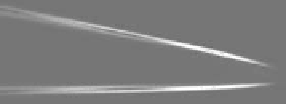Biomedical Engineering Reference
In-Depth Information
as a function of the slab width. We notice that for all the dispersions considered we have a bell-shaped
THG response, with a coherent increase followed by signal decrease due to the destructive interference
caused by the Gouy phase shift. Yet, in the case of negative dispersion, the dispersion partly compensates
the effect of the Gouy shift, and the destructive interference is not complete.
Interestingly, THG can be obtained from a homogeneous medium exhibiting strong negative disper-
sion, as demonstrated in the case of THG in gases [4]. However, this situation is usually not found in
cells and tissues, so that THG microscopy typically requires the presence of an interface or an inclusion.
3.2.8 interference effects
More generally, when several objects, or objects of different sizes are present within the excitation volume,
interference effects can result in increased or decreased THG intensity. This is illustrated in Figure 3.6a,
where thickness variations at the tip of a pulled glass pipette produce constructive and destructive inter-
ference. In Figure 3.6b, distance variations between two lipid droplets result in a local THG over-inten-
sity. We note that a similar effect has been described in SHG imaging of labeled vesicles [22].
3.2.9 orientation effects
In THG microscopy, phase matching is different in the transverse (
x
,
y
) and axial (
z
) directions. This
results in different THG efficiencies for structures oriented along different directions. The geometry we
consider here is an interface between a medium with a nonlinear susceptibility χ
(3)
and another medium
with the same linear index of refraction, but with a nonlinear susceptibility equal to zero. Figure 3.7d
illustrates the different geometries used in this section: we consider interfaces along the
x
-,
y
-, and
z
-axis, and calculate the THG signal as a function of the angle it makes around its axis.
In the case of an interface along the optical axis
z
(Figure 3.7a), there is a weak though nonnegligible
orientation dependence (≈ 20%). This is related to the transverse asymmetry of a linearly polarized beam
focused by a high
NA
lens, as will be illustrated later. More intriguing is the fact that far-field scatter-
ing occurs along two off-axis lobes. This phenomenon can be described analytically by considering 3D
phase-matching conditions:
Coherent THG scattering is efficient only along the directions that fulfill the following vectorial
phase-matching condition:
3
(
k
+
k
)
−
k
=
0
(3.19)
ω
G
3
ω
(a)
(b)
+
+
+
-
-
+
FIgurE 3.6
Examples of interference in THG images. (a) Original and zoomed THG images of the tip of a pulled
glass pipette. (b) THG images of lipid droplets in a rat hepatocyte. Arrows indicate local over-intensities result-
ing from interference. Scale bars: 5 μm. (Adapted from Débarre D 2006.
hèse de doctorat
. Ecole Polytechnique,
Palaiseau.)













